|
|
|
Sort Order |
|
|
|
Items / Page
|
|
|
|
|
|
|
| Srl | Item |
| 1 |
ID:
190024
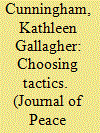

|
|
|
|
|
| Summary/Abstract |
Disputes over self-determination (SD) have led to many civil wars, and a primary alternative, nonviolent campaign, is rarely successful in this context. Yet, while secession is rare, these movements often achieve more limited successes in the form of concessions from the state. This article provides a new assessment of the efficacy of different tactics – violent, nonviolent and conventional political action. It advances an argument that nonviolent tactics can help SD movements to generate indirect pressure on states that contributes to movement success, including greater autonomy. Nonviolence is used to garner attention from international actors using a human rights frame for their cause. International actors that are receptive to these human rights narratives then incentivize concessions for the SD movements and dis-incentivize repression. This happens through a variety of means, such as public shaming of the host state and withholding inter-governmental organization membership. Statistical analysis of violent and nonviolent tactics in SD movements shows that nonviolence can be effective in successfully obtaining concessions. Movements that use nonviolence are twice as likely to see concessions in any given year compared to those that just make demands but do not use nonviolence or violence. The effect of nonviolence is slightly larger than that of violence, which is also associated an increased chance of concession.
|
|
|
|
|
|
|
|
|
|
|
|
|
|
|
|
| 2 |
ID:
167286
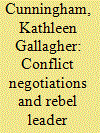

|
|
|
|
|
| Summary/Abstract |
The international community often calls for negotiations in civil wars. Yet, we have limited understanding of when and why specific rebels enter into negotiations. The emergence of a new leader in a rebel group can provide an opportunity for the state seeking to end war, but this is conditional on how leaders take power. Rebel leaders who come to power through a local selection process (such as an election) provide information to the state about the likely cohesion of the rebel group. This affects state perceptions of the viability of a rebel group as a bargaining partner in civil war negotiations. Using original data on rebel leaders in civil wars, we show that new leaders coming to power through a local selection process are more likely to get to the negotiating table than leaders coming to power in other ways. We find that the election of a rebel group leader has a particularly strong and positive effect on the chance of getting to the table. Rebel leaders that founded their own group or brought together disparate rebels to create a single group are less likely to get to the negotiating table. This article advances our understanding of conflict dynamics by offering a novel argument of rebel leader ascension and its impact on conflict bargaining and has critical implications for parties external to the conflict interested in conflict resolution. External actors seeking to facilitate lasting peace may benefit from observing patterns of rebel leadership.
|
|
|
|
|
|
|
|
|
|
|
|
|
|
|
|
| 3 |
ID:
110530


|
|
|
|
|
| Publication |
2011.
|
| Summary/Abstract |
Why do states make concessions to some self-determination movements but not others? This article explores the role of the internal characteristics of these movements, demonstrating that their internal structures play a major role in determining which groups get concessions. Using new data on the structure of self-determination movements and the concessions they receive, I evaluate whether states respond to internally divided movements by trying to "divide and conquer" or "divide and concede." Consistent with the latter approach, I find that internally divided movements receive concessions at a much higher rate than unitary ones and that the more divided the movement is the more likely it is to receive concessions. Yet, concessions to unitary movements appear to work better to settle these disputes. This suggests that states use concessions not only as a tool to resolve disputes, but also as part of the bargaining process.
|
|
|
|
|
|
|
|
|
|
|
|
|
|
|
|
| 4 |
ID:
143320


|
|
|
|
|
| Summary/Abstract |
Why are some ethnopolitical movements divided while others are relatively unified? A growing literature examines the consequences of internal divisions in ethnopolitical movements – and shows that it matters for a range of conflict outcomes – yet the mechanisms causing such divisions remain poorly understood. Our argument emphasizes competitive dynamics between states and self-determination movements and between rival factions within these movements as key determinants of fragmentation. Drawing from literatures on social movements, contentious politics, and civil war, we situate our argument vis-à-vis three alternative and complementary sets of explanations based on theories emphasizing transnational dimensions, political institutions, and structural factors within ethnopolitical groups. Using an original dataset, we test hypotheses explaining movement fragmentation over time and use a case study of Punjab in India to identify specific causal mechanisms and missing variables. Our findings show some support for three of these theories, suggesting that ethnopolitical movements divide as a result of complex and interactive processes. But our findings also underscore that central to explaining fragmentation dynamics are factors capturing competitive dynamics, including repression, accommodation of movement demands, the turn to violence, and the dynamic and changing nature of ethnopolitical demands.
|
|
|
|
|
|
|
|
|
|
|
|
|
|
|
|
| 5 |
ID:
173901
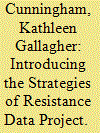

|
|
|
|
|
| Summary/Abstract |
This article introduces the Strategies of Resistance Data Project (SRDP), a global dataset on organizational behavior in self-determination disputes. This dataset is actor-focused and spans periods of relative peace and violence in self-determination conflicts. By linking tactics to specific actors in broader campaigns for political change, we can better understand how these struggles unfold over time, and the conditions under which organizations use conventional politics, violent tactics, nonviolent tactics, or some combination of these. SRDP comprises 1,124 organizations participating in movements for greater national self-determination around the world, from 1960 to 2005. Despite the fact that few self-determination movements engage in mass nonviolent campaigns, SRDP shows that more organizations employ nonviolent tactics at some point in time (about 40%) than employ violence (about 30%). Many organizations switch among tactics or use both at the same time. This dataset will allow analysts to examine the use of different combinations of tactics and patterns of change. We compare the data with the most-used dataset on nonviolence, the NAVCO 2.0 Data Project, to demonstrate what we gain by employing an organization-level dataset on tactics. We present a set of descriptive analyses highlighting the utility of the SRDP, including an examination of tactic switching. We show that more organizations change from violence to nonviolence than the reverse – challenging the widely held assumption that organizations ‘resort’ to violence. SRDP allows scholars to examine organizational choices about tactics, and trends in these tactics, with much greater nuance.
|
|
|
|
|
|
|
|
|
|
|
|
|
|
|
|
| 6 |
ID:
177010
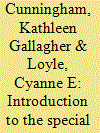

|
|
|
|
|
| Summary/Abstract |
Research on conflict processes has recently highlighted the myriad of tactics rebels use which are not violent in nature (cf. Petrova 2019; Ryckman 2020; Cunningham, Dahl, and Frugé 2017). Concurrently, rebel governance has drawn increasing attention from scholars and peacebuilding practitioners. In-depth historical studies of rebel groups highlight the activities and behaviors that rebels engage in beyond making war—such as providing social services and building local political institutions (Mampilly 2011; Arjona 2016a; Arjona, Kasfir, and Mampilly 2015). Complementing these works, studies have sought to provide cross-national examination of trends in these governance behaviors (Huang 2016; Heger and Jung 2017; Stewart 2018). Despite this work, quantitative and formal research in conflict processes often ignores the insights that the rebel governance literature has generated, frequently focusing exclusively on violent tactics or considering governance issues primarily as part of conflict settlement processes. In this special feature, we work to integrate the study of rebel governance with the conflict processes literature, providing a conceptual link between the two while offering novel contributions to advance our understanding of the dynamic processes of rebel governance.
|
|
|
|
|
|
|
|
|
|
|
|
|
|
|
|
| 7 |
ID:
154545


|
|
|
|
|
| Summary/Abstract |
Self-determination claims have abounded in the international system since the end of World War II. But these claims have not emerged everywhere. About half of the states in the international system face some challenge related to self-determination today. Why do some states face these demands while others do not? We argue that ethno-national self-determination is one of many identities with which individuals can find affinity. While an international norm related to self-determination has developed globally, its use as a basis for political claims has diffused regionally. Diffusion of self-determination occurs through observation of others using self-determination as a basis of organization, generating a sense of legitimacy, sensitivity to related grievance, and perceptions of tangible benefits related to self-determination identification. We test this empirically on global data on self-determination claims from 1960 to 2005 and find evidence of spatial diffusion, suggesting that self-determination is, to some extent, contagious.
|
|
|
|
|
|
|
|
|
|
|
|
|
|
|
|
| 8 |
ID:
112854


|
|
|
|
|
| Publication |
2012.
|
| Summary/Abstract |
The most prominent form of violent conflict in the world today occurs within states
rather than between them. Since 1945, over 75 percent of militarized disputes have
been civil conflicts.
1
From the African continent to the Balkans, civil wars have
raged and self-determination movements have mobilized for collective violence.
Conflict over identity has emerged as a central problem for nations and the internal
community as nationalist groups battle the state and each other in places like Iraq
and Sudan.
The comparative decline of conventional interstate war casts a spotlight on the
myriad of conflicts involving nonstate actors, be they in conflict with each other
or with existing states. We define a nonstate actor as an organized political actor not
directly connected to the state but pursing aims that affect vital state interests. The
dominant approach to analysis of conflicts involving nonstate actors views them,
like interstate conflicts, as the outcome of bargaining between antagonists (Fearon
1995; for review, see Walter 2009). This bargaining framework entails identifying
key players-typically just two-and specifying their preferences, the limits of their
capabilities and resolve, and the information they have about each other.
2
Given
such information, analysts derive predictions about when their strategic interaction
will result in conflict, as well as the characteristics of that conflict.
|
|
|
|
|
|
|
|
|
|
|
|
|
|
|
|
| 9 |
ID:
121584


|
|
|
|
|
| Publication |
2012.
|
| Summary/Abstract |
How do we conceptualize the fragmentation of internally divided movements? And how does variation in fragmentation affect the probability and patterns of infighting? The internal politics of non-state groups have received increasing attention, with recent research demonstrating the importance of cohesion and fragmentation for understanding conflict dynamics. Yet there is little consensus on how to conceptualize fragmentation, the concept at the center of this agenda, with authors using different definitions and measures. In this paper we conceptualize fragmentation along three constitutive dimensions: the number of organizations in the movement; the degree of institutionalization across these organizations; and the distribution of power among them. We then show how variation across these dimensions can explain variation in important conflict processes, focusing on infighting.
|
|
|
|
|
|
|
|
|
|
|
|
|
|
|
|
| 10 |
ID:
153657


|
|
|
|
|
| Summary/Abstract |
Many studies highlight the role that international intervention can play in prolonging civil wars. Yet, direct military intervention is just one way that external actors become involved in civil conflicts. In this article, a model is developed and analyzed that shows that when the government is unsure about how external support to the rebels will help rebel war-making capacity, it is the government that will continue fighting rather than settle the dispute. Different types of external support to rebels influence their fighting capacity differently, and some types of support create uncertainty about how new resources will translate into war-making ability. Specifically, more fungible sources of support (such as direct financial support) generate the most uncertainty for states as they attempt to estimate the effect of support to rebels on the conflict. Increased uncertainty inhibits bargained settlement, and disputes characterized by fungible external support are less likely to end than those where rebels receive different kinds of support. Empirical analyses demonstrate strong support for this argument; rebels that receive highly fungible external support (money and guns) are less likely to see conflict termination than rebels that do not.
|
|
|
|
|
|
|
|
|
|
|
|
|
|
|
|
| 11 |
ID:
101617
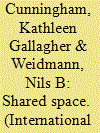

|
|
|
|
|
| Publication |
2010.
|
| Summary/Abstract |
Why does ethnic violence occur in some places but not others? This paper argues that the local ethnic configuration below the national level is an important determinant of how likely conflict is in any particular place. Existing studies of ethnicity and conflict focus on national-level fractionalization or dominance, but much of the politics surrounding ethnic groups' grievances and disputes takes place at a more local level. We argue that the existence of multiple ethnic groups competing for resources and power at the level of sub-national administrative regions creates a significant constraint on the ability of states to mitigate ethnic groups' grievances. This in turn increases the likelihood of conflict between ethnic groups and the state. In particular, we argue that diverse administrative regions dominated by one group should be most prone for conflict. Using new data on conflict and ethnic group composition at the region level, we test the theory and find that units with one demographically dominant ethnic group among multiple groups are most prone to conflict.
|
|
|
|
|
|
|
|
|
|
|
|
|
|
|
|
| 12 |
ID:
112857


|
|
|
|
|
| Publication |
2012.
|
| Summary/Abstract |
While theoretical models of conflict often treat actors as unitary, most self-determination groups are fragmented into a number of competing internal factions. This article presents a framework for understanding the "dual contests" that self-determination groups engage in-the first with their host state and the second between co-ethnic factions within groups. Using a new data set of the number of factions within a sample of self-determination groups from 1960 to 2008, the authors find that competition between co-ethnic factions is a key determinant of their conflict behavior. More competing factions are associated with higher instances of violence against the state as well as more factional fighting and attacks on co-ethnic civilians. More factions using violence increases the chances that other factions will do so, and the entry of a new faction prompts violence from existing factions in a within-group contest for political relevance. These findings have implications for both theory and policy.
|
|
|
|
|
|
|
|
|
|
|
|
|
|
|
|
| 13 |
ID:
120765


|
|
|
|
|
| Publication |
2013.
|
| Summary/Abstract |
The events of the Arab Spring of 2011 have made clear the importance and potential efficacy of nonviolent resistance, as well as the field's inability to explain the onset and outcome of major nonviolent uprisings. Until recently, conflict scholars have largely ignored nonviolent resistance. This issue features new theoretical and empirical explorations of the causes and consequences of nonviolent resistance, stressing the role that unarmed, organized civilians can play in shaping the course of conflicts. Contributors demonstrate the importance of treating nonviolent and violent strategies, as well as conventional politics strategies, as alternative choices for engaging the state, show how gender ideology can influence which opposition groups use nonviolent resistance, and suggest that the causes of civil war and nonviolent resistance often differ. Other pieces highlight the role of public attitudes regarding whether nonviolent resistance and violence are employed, how experience with activism and repression by the state can shape activists' perceptions of justice, and how the perceptions of resistance leaders can influence strategic choices. Moreover, several articles examine the key role that security force defections can play in the success of nonviolent resistance, how micro-level nonviolent tactics can improve security in civil war, and how nonviolent campaigns can influence the stability of autocratic states. These contributions suggest that rigorous empirical study of civilian-based contentious politics (rather than only violent contention by armed non-state actors) must be incorporated into the conflict literature. Improved theory and data on the subject will help researchers and policymakers to shape strategies to support these movements when appropriate, and to manage changes in the international system that result from the success of nonviolent uprisings.
|
|
|
|
|
|
|
|
|
|
|
|
|
|
|
|
| 14 |
ID:
120767
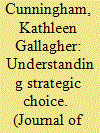

|
|
|
|
|
| Publication |
2013.
|
| Summary/Abstract |
What determines why some self-determination disputes develop into mass nonviolent campaigns, others turn into civil wars, and still others remain entirely in the realm of conventional politics? A great deal of work has addressed the factors that lead to violent mobilization, but less attention has been paid to understanding why disputes become violent or nonviolent, comparing these two as strategic choices relative to conventional politics. This article examines the determinants of strategy choice in self-determination disputes by analyzing how a variety of factors affect the costs and benefits of conventional political strategies, mass nonviolent campaign, and civil war. I find that civil war is more likely, as compared to conventional politics, when self-determination groups are larger, have kin in adjoining states, are excluded from political power, face economic discrimination, are internally fragmented, demand independence, and operate in states at lower levels of economic development. I find that nonviolent campaign is more likely, as compared to conventional politics, when groups are smaller, are less geographically concentrated, are excluded from political power, face economic discrimination, make independence demands, and operate in non-democracies. Examining the full set of strategies available to self-determination groups allows us to more accurately understand why these groups engage in mass nonviolent campaign and civil war.
|
|
|
|
|
|
|
|
|
|
|
|
|
|
|
|
| 15 |
ID:
177013


|
|
|
|
|
| Summary/Abstract |
Rebel actors engage in a number of behaviors beyond violent conflict, including social service provision, diplomacy, and establishing local governance. This article centers on an oft-overlooked aspect of rebel behavior and governance: rebel groups conducting popular elections in wartime. We argue that rebel elections are a means through which rebels can strengthen both local and international legitimacy, but that there are risks to employing elections (such as logistical failures or publicized disconnect from civilians). We hypothesize that rebels that are pursuing legitimacy (local and international) in other ways are likely to set up rebel elections and that rebel groups with greater organizational capacity are more likely to introduce elections because they are well placed to manage the risks elections entail. Using a global data set of rebel use of elections where local civilians vote to elect rebel representatives at various levels of organizational hierarchy, we find empirical support for these propositions.
|
|
|
|
|
|
|
|
|
|
|
|
|
|
|
|
|
|
|
|
|